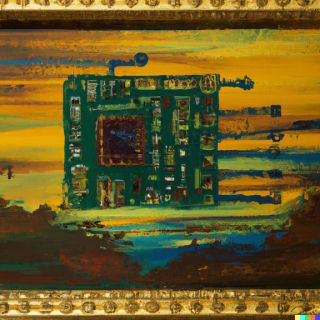Artificial Intelligence
AI and the Evolving Landscape of Creativity
Craft, cognition, and the co-creation conundrum.
Posted August 10, 2023 Reviewed by Jessica Schrader
Key points
- AI is revolutionizing how artists collaborate and create.
- Advanced technology transforms audiences from passive observers to active contributors.
- The era of co-creation challenges and expands traditional notions of artistry.

At this unique juncture in history, technology and creativity are intertwining in ways previously unimagined, leading us to an exciting crossroads. The conventional arenas of art and expression, deeply rooted in history and tradition, are undergoing a metamorphosis. This synthesis between the analytical prowess of artificial intelligence and the raw ingenuity of human imagination nudges us to reevaluate a fundamental query: As the contours of the creative world evolve, who becomes the true architect of a masterpiece?
AI: Beyond a Mere Instrument, an Artistic Partner
In eras past, the world of art predominantly drew from the wellspring of singular, personal inspiration. Artists, working in solitude, produced works that reflected their innermost thoughts and emotions. Yet, the contemporary landscape tells a riveting tale of change. AI, with its computational brilliance, is no longer a silent assistant. It’s a dynamic collaborator, playing a significant role in the creative process. At the heart of this alliance is the power of a well-crafted cognitive prompt. Analogous to a conductor guiding a symphony, our interaction and instruction with AI becomes the compass, directing the soul and character of the resulting art.
Audience Evolution: From Spectators to Contributors
The days when audiences were mere passive recipients, silently absorbing content, are receding. Today, thanks to innovative technological leaps, ranging from instantaneous feedback mechanisms to pioneering bio-sensing technologies, audiences may in the near future find themselves with a seat at the table. Picture this: a movie dynamically altering its storyline in response to the viewer’s emotional cues, or a musical composition that ebbs and flows with the rhythm of the listener’s heartbeat. Early studies have suggested that our underlying physiology may provide the template for "bio-editing" to support artistic content. These concepts, although in their nascent stages, spotlight the potential and game-changing nature of integrating audience feedback into the art creation process.
Highlighting the significant implications of this shift, global giants like Disney have not only taken note but acted upon it. By inaugurating an AI-centric task force, Disney aims to probe into an array of domains, from bolstering creative processes to redefining marketing strategies. This proactive approach is a testament to a larger industry trend — one that underscores the pivotal relationship forming between AI and artistic creation.
Co-Creation: The Dawn of a Unified Artistic Endeavor
Welcome to the age of co-creation, where the lines blur between the creator, the technological ally (AI), and the audience. This rich tapestry of collaboration challenges and redefines traditional boundaries, venturing into unexplored domains of both individual inspiration and communal expression.
As we journey through this creative and transformative epoch, one thing becomes clear: The world of art and creativity is in a state of flux, constantly evolving and expanding its horizons. The harmonious dance between AI, artists, and the engaged audience is sculpting new art forms, enriching our comprehension and reverence for the vast world of creativity. As we look ahead, the expanse of artistic possibilities seems boundless, filled with promise, exhilaration, and a few bumps along the way.


